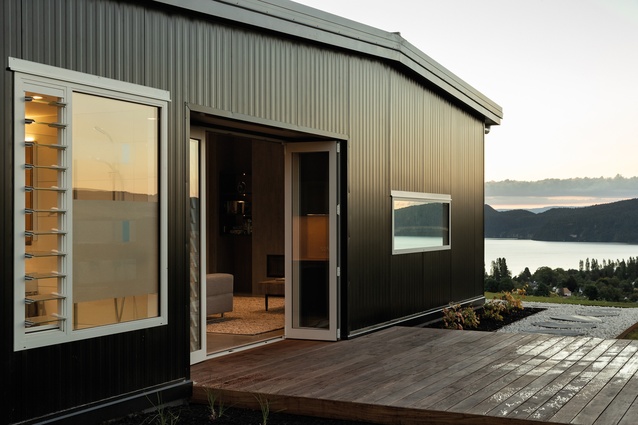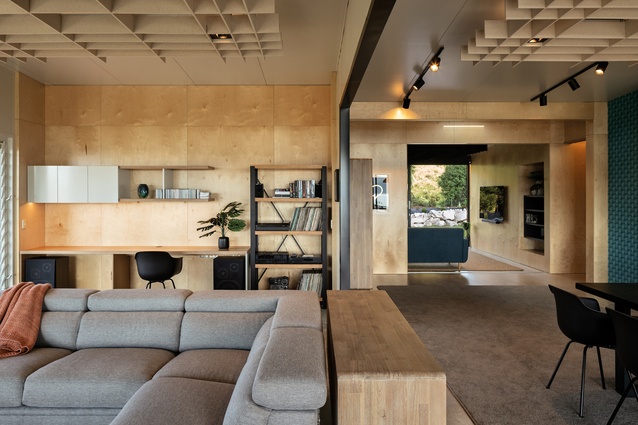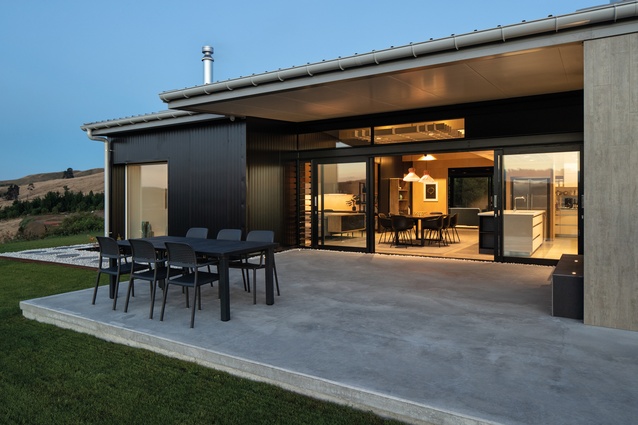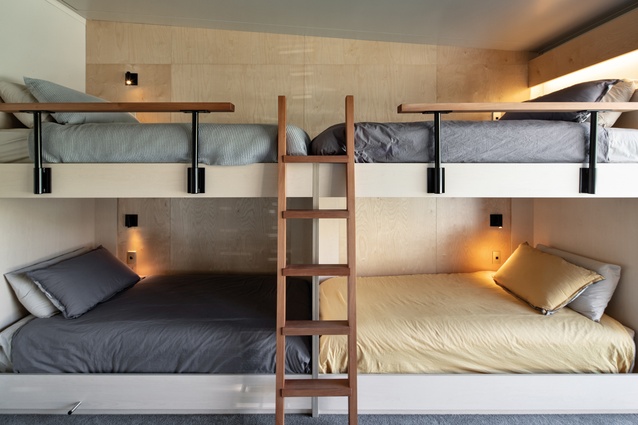Black beauty: Kinloch House
A fresh take on an unconventional building material by Malcolm Taylor and Associates has resulted in an energy-efficient, low-maintenance house that is turning a lot of heads.
As you head north-west from Taupo on Poihipi Road, snaking silver geothermal pipes soon give way to rolling farmland and the promise of a rural escape.
Not long after, you come across Kinloch, a small lakeside community on the northernmost shore of Lake Taupo, perhaps best known for its fishing, if the name of the local restaurant, The Tipsy Trout, is anything to go by.
Originally a sheep station, the land was bought by former New Zealand Prime Minister Sir Keith Holyoake and yachtsman Ian Gibbs in 1953, both of whom saw its potential for fishing, golfing and nature enthusiasts. Today, bush-clad mountain biking trails are an added string to its bow.
John Callesen has been visiting Kinloch for as long as he can remember; his aunt and uncle were amongst the first to build a bach down by the water. His memories of the village are sweet: so much so that he and his wife, Suzanne, bought their own piece of land high on an easterly hill overlooking Whangamata Bay two years ago.
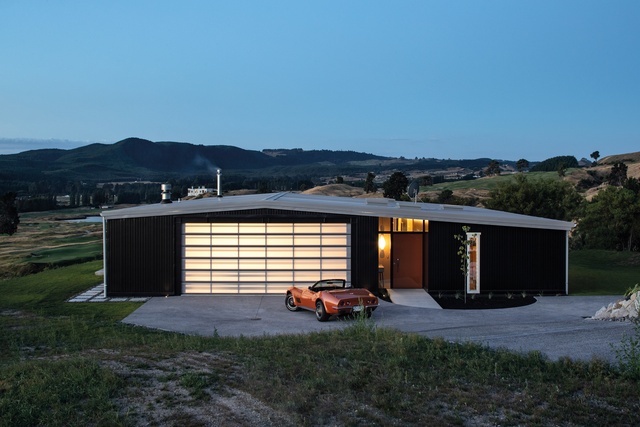
The couple called on good friend and architect Malcolm Taylor to design their new home – Malcolm and John have known each other since they were boys and still regularly play music together.
The panhandle-shaped section in some way dictated the dramatic entrance to the house at the end of the drive, where a solid black wall is punctuated by a strip of translucent cladding, marking the double garage, and a distinctive burnt-orange front door. What is perhaps most striking as you enter the house is the incredible sense of quiet, almost as if the house were hermetically sealed. This, even though there are several guests just metres away down the hallway.
The most logical explanation for the silence (and warmth) is Taylor’s unconventional use of building materials: in this case, crisp, black composite steel and polystyrene insulated panels, which are more commonly found in utility buildings and storage sheds.
Here, the use of the prefabricated panels for both the roof and the walls considerably reduced the amount of time and energy spent on site, when compared with what would have been required had traditional building methods been used. The overall cost of the build was reduced as well.
“It’s not like we reinvented the wheel,” says Taylor, who had previously used the panels in his award-winning Big Sky Farm House in Ngātea, which the Callesens had visited. “We’re just being clever about a product that’s been around for a long time.”
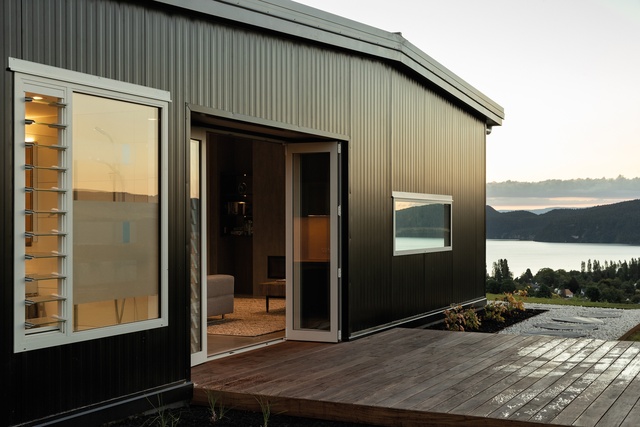
And the product itself is clever; its use as a roofing material offers 250mm of insulation – more than double that of a standard home – and its zero thermal bridging compares to an average 16 per cent heat loss experienced through the studs of standard framing. Another positive is that the windows can be delivered to the site and the openings cut into the panels to fit; this process minimises any risk of mismeasurement and maintains a solid building envelope and dry interior throughout the construction period.
The house is essentially designed as three black boxes – two bedrooms and a bathroom on the private, eastern side, the living and master bedroom at the northern end, and the garage and laundry to the south-west.
In the centre, the functional service spaces (kitchen, scullery and bathrooms) are articulated materially with plywood, creating a clear logic in spatial design but also offering a warm, natural contrast to the rich black panels. The bedrooms, too, have plywood-clad walls, affixed with simple panel gun staples – an honest finish that delivers on the modest bach vernacular – as do the repetitive, modularised windows and louvres placed down the eastern side of the house.
The design makes the most of the site’s high vantage point and extensive views, neatly framing the fortress-like Kinloch Manor overlooking the golf course to the north and opening out to a covered terrace and lake views beyond to the west.

“We overcame the urge to open everything up,” explains Taylor, “but, rather, we’ve kept some areas contained and protected, gradually peeling back the spaces to reveal the views.”
Taylor’s design eye is evident throughout the project, from the bespoke acoustic baffling overhead in the living and media rooms, which also houses directional lighting, to the custom plywood detailing around the internal door frames, built-in units and even a bunk-end cupboard door that doubles as a vertical wooden shutter for a bedroom window.
This simple, unpretentious craftsmanship harks back to the Group Architects’ thinking of the 1950s, aiming to provide efficient, low-cost buildings for “the man in the street”, furnished simply with “a few well-chosen, well-designed pieces”.
Taylor’s vision was to create a casual, utilitarian home for the owners, both humble and modestly scaled. The materials he chose played a crucial part in delivering on that vision and, some may say, have led to him reinventing and updating the traditional Kiwi bach typology.
Material Palette

Malcolm Taylor discusses the use of the Metalcraft insulated panel system for internal and external walls and roofing.
Tell us more about these panels and the ways in which they have been used historically.
Malcolm Taylor (MT): The dairy, fruit, wine and construction industries have used ‘cool store’ panels for 40 years now, for both storage and refrigeration sheds. In using them for residential projects, we have elevated the connection details to an entirely new level of care and have come to understand how the panels expand and contract and how to mitigate thermal bridging to the roof soffit. We’re coming to grips with how to take advantage of building with this super-insulated, cost-efficient product but the benefits are hard to go past – this entire project came in at just under $3000 per square metre, including furniture and appliances.
Do they present any challenges to the design?
MT: This is an alternative solution to the New Zealand Building Code, so we need to have the engineers, designers and manufacturers working in unison, and the end product needs to be certified by the manufacturer. They can be both liberating and restricting. Roof spans, construction speed and fewer weather limitations are all positives but building above a single storey and/or close to the coast would be a challenge. It’s very much a ‘horses for courses’-type solution.
This article first appeared in Houses magazine.



